One part says, “It is so lovely and cozy here in my bed. I wish I could stay here all day!”
The other part says, “Remember your New Year’s resolution! You promised you are going to get up every morning, lay out your mat, and do yoga, and you must do this no matter how exhausted or stressed you feel!”
In reality, you may have 10 minutes to yourself, whether in bed or out, before you need to get into gear. You need to get your kids ready for school, or catch the subway to the office, or a do million other things. You have 10 precious minutes and you can’t make both the “stay in bed” and the “do yoga now” parts of yourself happy at the same time ... or can you?
A great way to make both of these parts happy, and counteract the Monday blues, is to hit the metaphorical reset button by practicing bed yoga.
I am a health educator in the Department of Integrative Health Programs at New York University’s Langone Medical Center. In partnership with the Monday Campaigns’ DeStress Monday initiative, we have created an easy-to-follow video called “Monday Morning Bed Yoga.” It is less than 10 minutes long, but if you don’t have that much time to spare in the morning, you can adapt this practice to your needs by choosing one or two sections that you like and leaving the rest for another time.
By waking up with bed yoga on Mondays, it is possible to start the week fresh, feeling recharged for the rest of the week. With a small time commitment each morning, in the comfort and privacy of your own bed, you may experience many benefits of yoga, including increased vitality, better emotional balance, an uplifted spirit, a healthier and more relaxed body, and a more peaceful, focused mind.
You may even find that some of the aches and pains we carry when we don’t stretch enough, as well as when we don’t rest enough, diminish considerably or may even disappear over time. Yoga in bed can also be a practical beginner’s way to safely and gently introduce yourself to this time-honored practice that doesn’t require special clothing, sticky mats, or even getting out of bed!
Obviously, you are not going to stand up on your mattress and start doing sun salutations, so how does yoga in bed work? Here are some yoga poses to try. Pick one or two to start with, or do them all. You can also follow along with our “Monday Morning Bed Yoga” video.
Reclining Twist Pose:
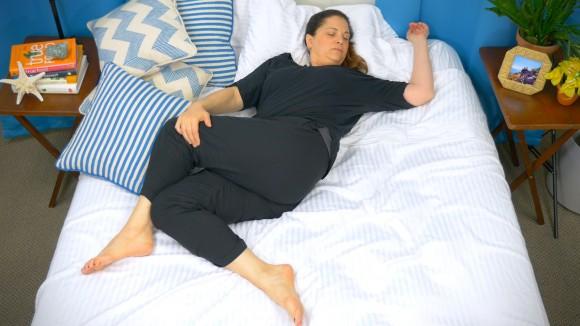
My favorite bed yoga pose is the reclining twist. It is a great way to get started in the morning, especially for those who wake up with a stiff lower back. Lie on your back and take a deep breath. Exhale while bringing your left leg over the right leg. Gently twist, dropping your knees to the right, while turning your head to the left. Hold for two or three breaths, or as long as comfortable. Repeat on other side.
Cat Stretch Pose:
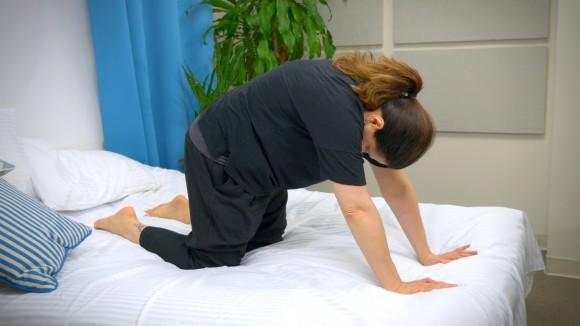
We can take a cue from our feline friends and do a Cat Stretch (dogs do this too!). First, kneel and place your hands on the bed, with arms extended and shoulders above your hands. As you exhale, arch your back, and drop your chin to your chest. If your wrists hurt in this position, make fists instead. Hold for a few seconds.
Back Stretch Pose:
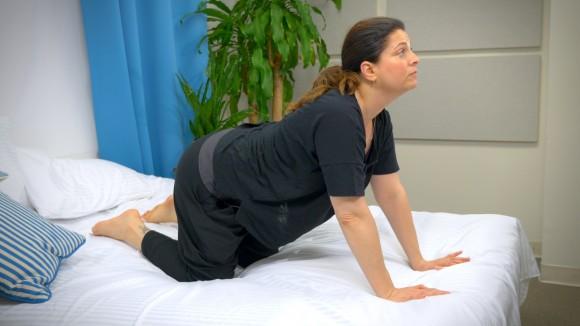
Then, as you inhale, extend your spine, drop your belly downward, and look up, feeling a nice stretch under your chin. Hold for a few seconds. Continue alternating between these two positions for a few rounds, as feels comfortable for you.
Legs Up The Wall Pose:
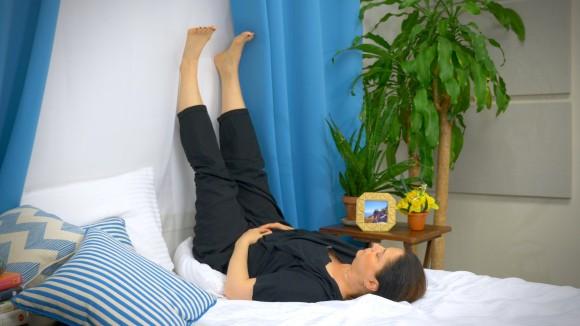
Another favorite of mine is Viparita Karani, the legs up the wall pose. This can be great for relieving discomfort in tired feet. It also aids venous return of blood flow to the heart while you rest. Place your legs up the wall and relax for a minute, taking a few deep breaths. Feel the belly rise and fall with each breath. This can be a very peaceful, meditative pose.
Hips Stretch Pose:
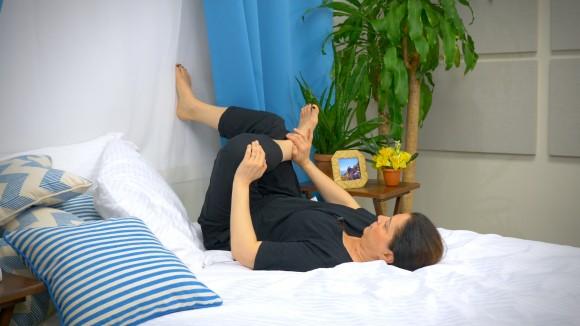
If you have tight hips from sitting a lot, the following pose can be very helpful. Bring knees into a right angle with feet flat on the wall, then place left ankle onto your right thigh. Feel the stretch in the muscles of your left hip. Please do not place any pressure on your knee, but gently push against your left thigh for a few seconds as you take some deep breaths. Repeat on your other side.
Happy Baby Pose:
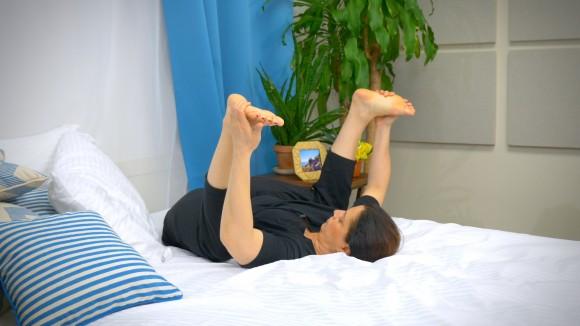
It can be fun to let go of grownup posture for a second and let your body enjoy a shape babies make, by practicing the happy baby pose. Gently take hold of your feet or ankles, and slowly bring your knees toward your armpits for a few seconds. Press your tailbone down into the bed for a few seconds, then release again. Breathe.
Child’s Pose:
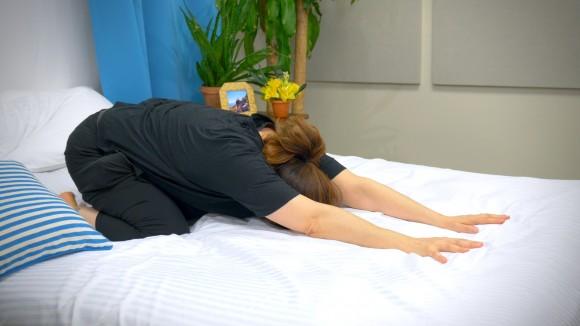
It’s nice to end your practice with Balasana, the child’s pose. Kneel with your knees wide apart and your toes touching. Sit up straight, lengthening your spine through the top of your head. Ease your torso back toward your thighs, and stretch your arms out in front of you, allowing your forehead to rest on the bed. Hold this stretch as long as feels good, and take some deep breaths.
Seated Position:
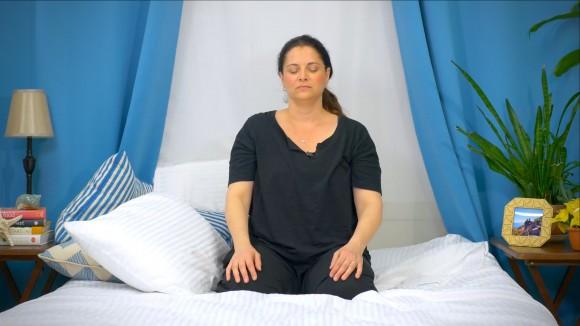
Please always remember that there should be no pain in yoga. If anything suggested here hurts, please back off—be kind and gentle to yourself!
Amy Eberhardt, MPH, LMT, CPMT, CIMT, CYT, is a health educator and integrative health practitioner with the Department of Integrative Health Programs at NYU Langone Medical Center and a collaborator with the Monday Campaigns.
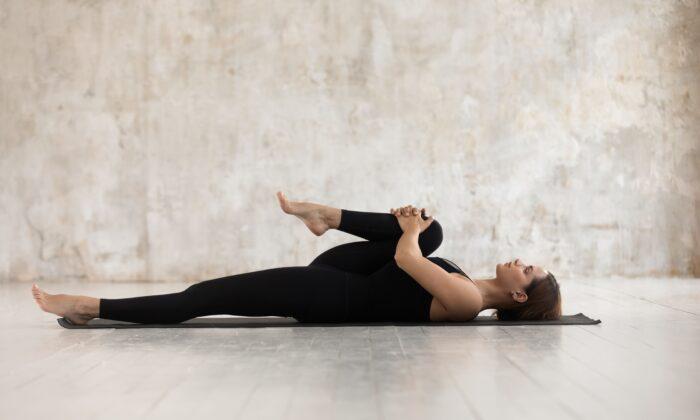
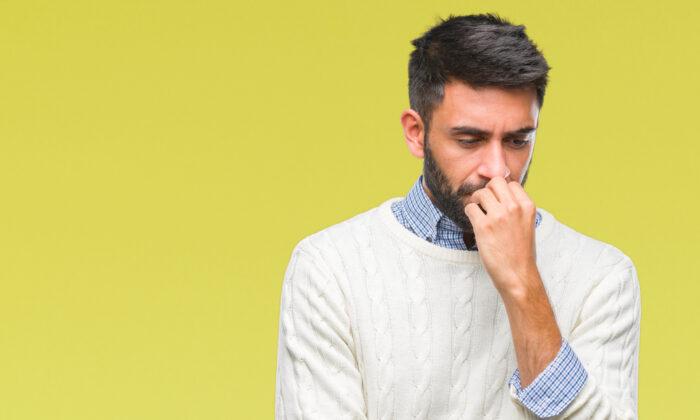
Friends Read Free